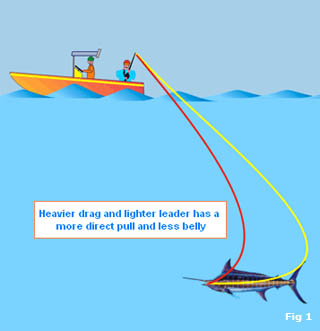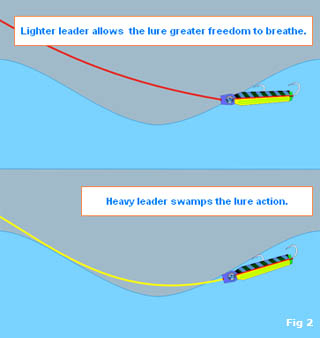04. Leader Choice
Between The Lines - Ch 05: Rigs
 One of the most important choices a game fisherman makes is what size and length leader to use. There is a huge difference between the thought processes in game fishing and just about all other forms of fishing and the decision-making that goes into choosing the leader is largely underestimated. In game fishing, the thinking is to use thick, long, strong leaders so as to lessen the chances of losing any fish that is hooked. In all other forms of fishing, the thinnest, shortest leader is generally used. The philosophy is that the better the presentation the more fish you will hook and the more chances you have of catching more fish.
One of the most important choices a game fisherman makes is what size and length leader to use. There is a huge difference between the thought processes in game fishing and just about all other forms of fishing and the decision-making that goes into choosing the leader is largely underestimated. In game fishing, the thinking is to use thick, long, strong leaders so as to lessen the chances of losing any fish that is hooked. In all other forms of fishing, the thinnest, shortest leader is generally used. The philosophy is that the better the presentation the more fish you will hook and the more chances you have of catching more fish.
We assume all the species we chase are somehow less intelligent and can't see very well, simply because we call them gamefish, despite the fact they are the apex predators of the seas. Some assume their aggression makes them throw caution aside and that they will attack anything that moves. However, a little observation indicates this does not seem to be the case. By the way fish react, it would seem leaders are a very important part of the overall presentation. In fact, the thicker and longer the leader, the more cautious the fish seems to be, even though nearly all leaders used on game fishing lures are nylon.
Over the years anglers lose a great many fish for many reasons. Some reasons are very common such as line breaking or the hook falling out. These and many others are accepted ways of losing fish. With few exceptions, less than one percent of all fish lost are due to the leader being worn through by a fish. This does not include fish that have sets of razors in their jaws that easily slice any thickness of leader used. Nor does it include areas where only monsters are hunted and long drawn out battles are expected.
Unfortunately, there is no definitive formula to ascertain what leader should be used and when. However, there are some factors that should be considered to gain a better understanding.
One important factor is to ascertain how long you expect to fight a fish. If most of the fish you are likely to encounter in your area take an hour to land then you'll need a leader that lasts at least three to four times that time. Remember, fish caught on lures are hooked in the mouth and most of the wear will be from the body or bill, not from the jaw.
How much drag will you put on the fish? This has two main objectives. Light drag means the leader will lie along the fish's body for a great deal of the fight. Heavy drag will keep the leader away from the fish's body but will increase the wear on the leader if it rubs against any part of the fish. The longer the leader the harder it is to keep the line on a direct pull on the hook as there will be a belly of line as the leader is pushed behind the fish. During a fight, the line has varying amounts of belly in it. The factors that affect the size of the belly are:
 The more line in the water the greater the belly.
The more line in the water the greater the belly.
The less the drag setting on the reel the more belly.
The thicker the line the greater the drag it has and the larger the size of belly it forms.
The longer and thicker the leader the more belly is in the line.
The faster the fish goes, the greater the belly of line trailing behind the fish. (Fig 1)
This is often seen when a fish surfaces some distance away and the line is still pouring off the reel in a totally different direction.
Another factor in presentation is an awareness of the effect of leaders on a lure's performance. The thicker the leader the more restricted the lure's action will be. The longer and thicker the leader the more 'baggage' the lure has to carry. An important part of tuning lures for maximum effect is the ability to increase the angle of entry. (Fig 2) This adjustment is difficult to do effectively if the lures carry long thick leaders.
Certainly there are some lures that carry 'baggage' better than others, but even so, just the sheer thickness of leaders is enough to make some fish cautious.
Short leaders allow you to tag or gaff off the rod tip rather than grabbing the trace first and risk pulling the hooks.
Other factors to consider with leaders are the stretch and stiffness of the leader. The softer the leader material the more likely it is to stretch. This can cause problems when putting a severe strain on a fish when tracing as the wraps can jam on the gloves. Also, softer leaders do not  have the same abrasion resistance as stiffer leaders. Despite the fact stiffer leaders are from many aspects more desirable, stiffness does restrict lure action. This can be overcome by using a thinner stiff leader in place of a thicker softer one. The ideal is a leader that is stiffer than it is thick with high abrasion resistance such as Stren High Impact Monofilament Leader.
have the same abrasion resistance as stiffer leaders. Despite the fact stiffer leaders are from many aspects more desirable, stiffness does restrict lure action. This can be overcome by using a thinner stiff leader in place of a thicker softer one. The ideal is a leader that is stiffer than it is thick with high abrasion resistance such as Stren High Impact Monofilament Leader.
A more obvious reasoning behind leader choice, most often overlooked, is because most lures are tuned by watching the lure face on from the back of the boat, where this may not be evident to eyes not trained to see the following:
The thicker the leader the more likely the leader will have its own vibration and bubble trail which is often struck by fish instead of the lure. This can also be seen when using heavy leaders, fish will often come in front of the lure to check this out. The mistake is often made in assuming the fish is billing the lure, where it is more likely the fish is accurately targeting the vibration and smoke trail of the leader. A sign of this is heavy scuffing and abrasion on the leader some distance away from the lure after a strike and foul hooked fish.
The 'Leader Trail' is rarely noticed by anglers, (Vid 1) it is difficult to see from the surface, and even when using trolling cameras the angle of the sun, water clarity, and distance of the camera to the lure all restrict our view.
Vid 1: The 'Leader Trail' is rarely noticed by anglers.
The leader bubble trail and vibration increase with the thickness of the leader, the trolling speed and the scuffing of the leader caused by abrasion on marlin bills, jaws and general wear. Apart from losing strength the increase of the leader trail of worn leaders is one of the main reasons for changing leaders after every fish, even though it may only have slight surface scuffing which would not weaken the leader enough to risk losing a fish.
An important aspect of lure performance in its working cycle is how far the lure dives below the water's surface. The further it dives and the longer it stays in a straight track maintaining its bubble trail, the easier the target is for the predator, which results in better hook-up rates and cleaner strikes. The lighter the leader the deeper the lure will dive and the longer it will maintain its straight course. (vid 2)
Vid 2: The lighter the leader.....





